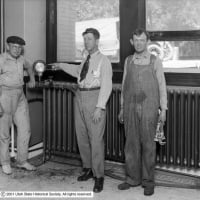Welcome! Here are the website rules, as well as some tips for using this forum.
Need to contact us? Visit https://heatinghelp.com/contact-us/.
Click here to Find a Contractor in your area.
If our community has helped you, please consider making a contribution to support this website. Thanks!
flow restriction?
Options
kevin coppinger_4
Member Posts: 2,124
is it an old gravity system....
<A HREF="http://www.heatinghelp.com/getListed.cfm?id=323&Step=30">To Learn More About This Professional, Click Here to Visit Their Ad in "Find A Professional"</A>
<A HREF="http://www.heatinghelp.com/getListed.cfm?id=323&Step=30">To Learn More About This Professional, Click Here to Visit Their Ad in "Find A Professional"</A>
0
Comments
-
After pulling the next set of rads from my 4-plex, the front rad with 1 1/4" nipples had a small disc in the valve that reduced the flow to 1/2"...in the union. Is this done to balance the system after converting from gravity?
Tim
To Learn More About This Professional, Click Here to Visit Their Ad in "Find A Professional"Just a guy running some pipes.0 -
yes, converted some time ago...ooooooold B&G pump on the floor next to boiler.
To Learn More About This Professional, Click Here to Visit Their Ad in "Find A Professional"Just a guy running some pipes.0 -
Q&A on Gravity HW Systems
I agree with Kevin- most likely gravity...
See this:
http://www.heatinghelp.com/heating_howcome1.cfm
It pays to wander off the wall...
About a third of the way down.
Excerpted below:
Q: So the top floors tend to heat more quickly than the bottom floors in a gravity system?
A: Yes, and that leads to system imbalance.
Q: How did the old-timers get around this problem?
A: They sometimes added orifice plates to the top-floor radiator hand valves. Here's what one looks like.
[Plates] See Photo in Link
Q: What exactly is an orifice plate?
A: It's a round piece of metal with a small hole drilled through its center. You could make one yourself out of sheet metal; most of the old-timers made their own.
Q: How did the orifice plate direct the water?
A: By increasing the resistance through the radiator it was assigned to. If water found it difficult to enter, say, a top-floor radiator because of the orifice plate, it would go to a radiator on a lower floor instead. In this sense, the orifice plate was similar to the "O-S" and "Monoflo" fitting. The big difference, however, was that instead of directing the water into the radiator it was assigned to, an orifice plate directed the water away from that radiator.0 -
\"ooooooold B&G pump on the floor next to boiler\"
Betcha that pump is oversized. How many square feet EDR is on that system (EDR, not the building's heat loss calc)?
Read this too:
http://www.heatinghelp.com/newsletter.cfm?Id=125
To Learn More About This Professional, Click Here to Visit Their Ad in "Find A Professional"0 -
yep,,,
Thanks to Dan H on the story about the radiators flow restrctors... Shortly after reading the article, a woman called and said she was having overheating problem on 2nd floor and never had it happens in her 6 years living there.... I asked her how did the floor refinishing job go and she freaked out like I was into some goverment conspiracy of gettin into people's private life... I explained to her that when the refinishing job in progress, they removed the radiators to avoid ugly spot under neath the units, doing it so, the restrictor often fall out unknowliy what it for get chucked.. til next heating season..0
This discussion has been closed.
Categories
- All Categories
- 87.3K THE MAIN WALL
- 3.2K A-C, Heat Pumps & Refrigeration
- 61 Biomass
- 429 Carbon Monoxide Awareness
- 120 Chimneys & Flues
- 2.1K Domestic Hot Water
- 5.8K Gas Heating
- 115 Geothermal
- 166 Indoor-Air Quality
- 3.7K Oil Heating
- 77 Pipe Deterioration
- 1K Plumbing
- 6.5K Radiant Heating
- 395 Solar
- 15.7K Strictly Steam
- 3.4K Thermostats and Controls
- 56 Water Quality
- 51 Industry Classes
- 50 Job Opportunities
- 18 Recall Announcements
